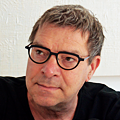Componist: Leo Küpper
Léo Kupper – Complete Electronic & Voices Works 1961-1987 (Part I).
Leo Kupper was born in Nidrum, Hautes Fagnes (Eastern Belgium) on the 16th of April 1935. He studied musicology at the Liège Conservatory, then became the assistant of Henri Pousseur who, in 1958, had just founded the Apelac Studio in Brussels. Kupper started to work on his first pieces there, but he would finalize them only upon putting together his own studio in 1967: the Studio de Recherches et de Structurations Electroniques Auditives (which means ‘studio of audio electronic research & structuring’).
That is where he would compose, to this day, over forty works, most of them on instruments of his own design. In the ’70s and ’80s, he built a series of Sound Domes (briefly established in Rome, Linz, Venice, and Avignon), places where every sound, every phonem uttered by the listening audience was transformed by hundreds of loudspeakers of various sizes organized in a dome shape. This device transformed sounds through space AND time: something said could be morphed into another sound hours, days, perhaps years later. Leo had envisioned that a device like his, a place for contemplation, would be much-needed in cities where Nature had been evacuated. In the late ’70s, after discovering Iranian music master Hussein Malek, Kupper became one of the very few Western virtuosos of the santur. His first pieces were released by Deutsche Grammophon and, later, Igloo. His latest works have been released by the New York-based label Pogus.
1/ INNOMINÉ. 1966-74. 25’55.
Composed in the 1960s with the sounds of the GAME, and mainly completed in 1968, revised in 1974. Mixed by Exequiel Virasoro (Channel Modulation), vocals by Alessandra Mihail (Vocal Sounds). ‘Innominé’ (an adjective qualifying what has not yet received its meaning or its name) is an electro-vocal work associating the sounds of the GAME with phonetic sounds emitted by the mouths of Alessandra Mihail (a Belgian actress who died very young) and students (Arab, Canadian, Chinese, Danish or French young men and women). In the first part, a girl’s complaints and reproaches call for unknown and painful experiences (a premonition of Mihail’s own tragic future!). Sounds from the ‘GAME’ accompany the actress in her expression. The second part, which essentially consists in electronic sounds programmed on the GAME, offers a long ‘Litany’ of spectral and dynamic sonic waves. This slowly growing sonic swell is mysteriously toned down before its ultimate explosion. From this explosion emerges the third part, a phonetic and poetic fantasy which the students perform over phonetic noises and electronic sounds that are triggered in the GAME by their voices, and placed in a stereophonic field.
2/ AUTOMATISMES SONORES. 1961-67. 26’19.
A process composed in the 1960s. This composition was entirely realised with the GAME. It associates a series of phrase-like sequences of various sonic natures. In this work, all the sounds result from a programming of the automatic machine played in retroaction with the microphone and recorded on tape (at a time when only mono recording was possible). It is a sonic exploration of the possibilities of the automatic machine (with a variety of harmonic sounds, impulses and noises). When there were several tracks (resulting from multiple programmings), the microphone redirected them into one single channel. The various phrases also correspond to various sonic moods and ambiances (Japanese and Indian influences can be detected, along with the presence of sounds imitating nature — forests, animals…). Each phrase moves into another through the rising and breaking of noise waves. For information, in the last one, the micro-sounds that can be heard were all pasted together on magnetic tape and came from the 1965 Siemens Lochbandstreifen machine.
3/ AÉROSONS. 1982. (excerpt).
For phonetic micro-sounds and electronic sounds. Composed in 1982. ‘Aérosons’ is based on the crossing of linear electronic sounds. These sounds sometimes tilt (in losing height), thus giving the impression that one is travelling through sound. Their linearity is therefore split in noise blocks (micro-phonetic sounds) and shorter electronic sounds. After the opening glides, the composition opens a central hovering space with granular modulations expressing a desire for summits. A final part brings about the progressive extinction of the work. Those were the days when the easily trippy sounds of electronic music were being invented.
Leo Kupper Brussels, Spring 2002 Revised and completed, Autumn 2020.
Sub Rosa Label.









